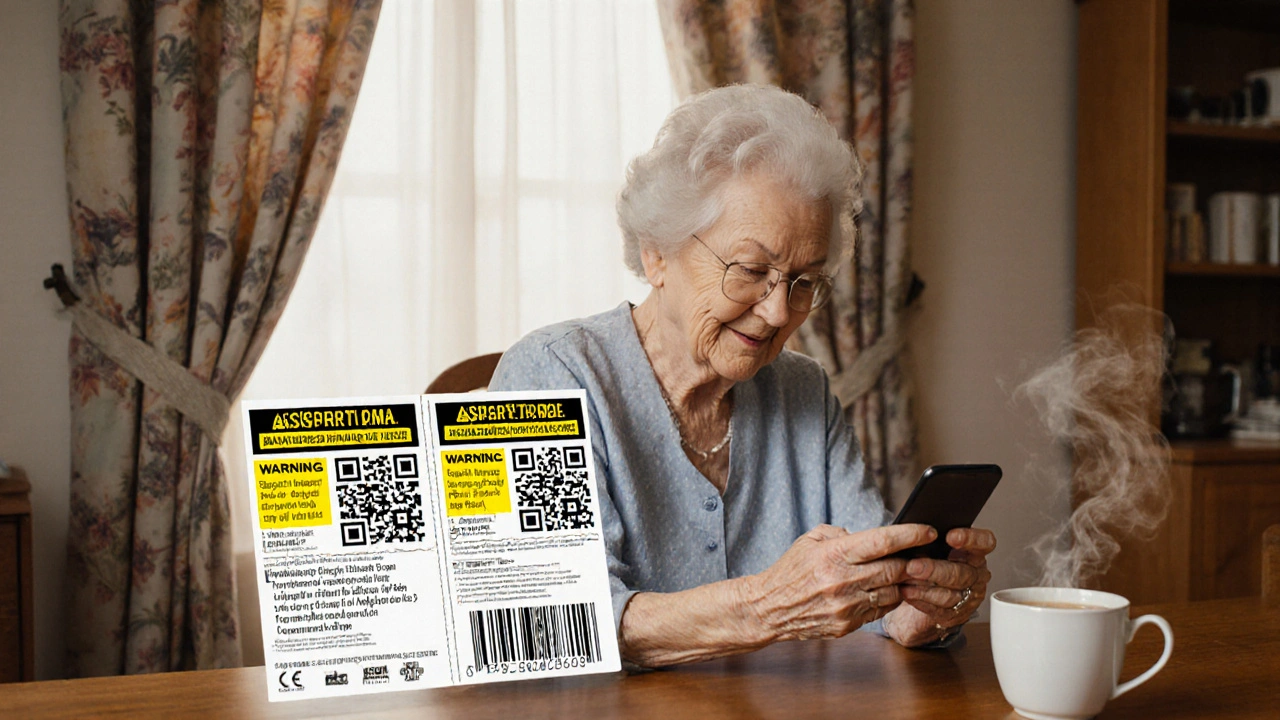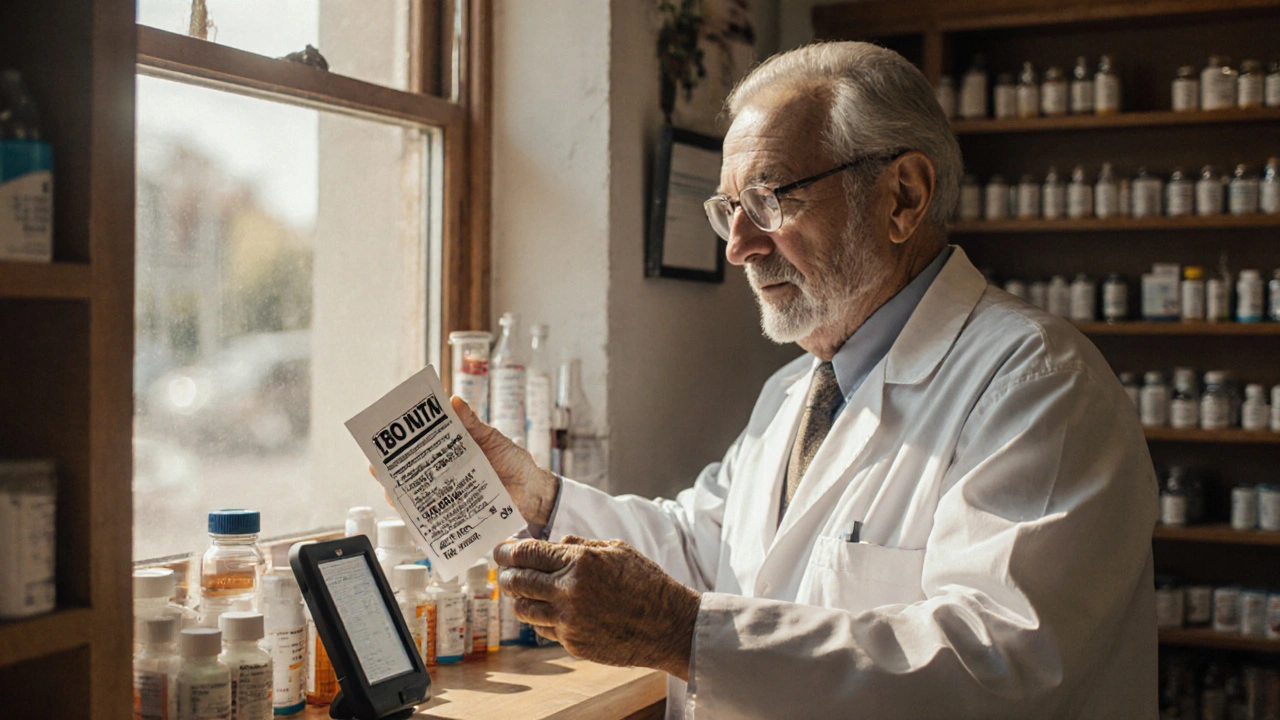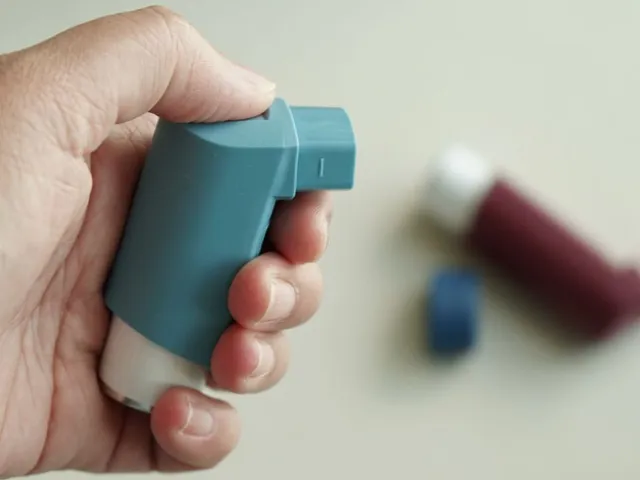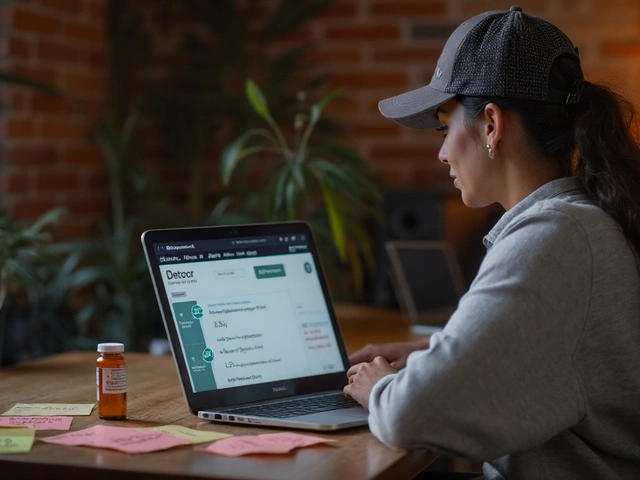Imagine opening your medicine cabinet and not being able to read what’s inside. Not just a little blurry - but completely unreadable. For millions of people with low vision, this isn’t a rare moment. It’s daily life. And the stakes? Life or death. Taking the wrong pill, at the wrong time, in the wrong dose - it happens more often than you think. That’s why large print and accessible prescription labels aren’t a luxury. They’re a necessity.
Why Standard Prescription Labels Fail People with Low Vision
Most pharmacy labels are printed in tiny, 8- to 10-point font. That’s about the size of a grain of rice. For someone with macular degeneration, glaucoma, diabetic retinopathy, or just age-related vision loss, that’s unreadable. A 2021 CDC survey found that 20% of adults over 45 struggle to read their own prescription labels. That’s one in five people. And it’s not just about inconvenience. The National Center for Biotechnology Information found that people with low vision take the wrong medication up to three times more often than those with full vision. The problem isn’t just the font size. It’s the layout. Dark gray text on light yellow backgrounds. Mixed uppercase and lowercase. Tiny symbols for dosage times. No clear separation between drug name, strength, and instructions. One study showed that even with magnifiers, patients took 8 seconds longer to read a standard label - and that delay can mean a dangerous mistake.What Makes a Prescription Label Actually Accessible
Accessible doesn’t mean bigger font alone. It means thoughtful design. The American Foundation for the Blind (AFB) and the Access Board have set clear standards, and pharmacies that follow them see real results.- Font size: 18-point minimum. Anything smaller won’t work for most low vision users. Studies show 14-point is the absolute floor - but 18-point is the safe standard.
- Font type: Sans-serif only. Arial, Verdana, or APHont™ (a free font designed by the American Printing House for the Blind) are best. Serif fonts like Times New Roman have little lines that blur together for low vision eyes.
- Color contrast: Black on white. No beige, no gray, no pastels. High contrast is non-negotiable. Glare-free paper matters too - glossy labels reflect light and make reading impossible.
- Layout: Left-aligned, lowercase text, uppercase numbers. Instructions like "take 2 TABLETS at 8 AM" are easier to scan than "Take two tablets at eight a.m."
- Yellow highlighting for critical info. Words like "Take with food" or "May cause drowsiness" get a yellow background. It’s simple, but it works.
The Three Main Types of Accessible Labels
Not all accessible labels are the same. There are three main systems in use today - each with strengths and limits.1. Large Print Labels
This is the most common and easiest to use. No tech needed. Just bigger text. Most major chains - CVS, Walgreens, Walmart - offer this for free. You don’t need to ask twice. If you have low vision, say: "I need my prescription label in large print, 18-point Arial, black on white." They should have it ready. The downside? Space. A standard pill bottle doesn’t hold much text. That’s why duplicate labels exist. Some pharmacies now use extra-long labels that wrap around the bottle or attach as a separate card.2. Audible Labels (ScripTalk)
ScripTalk is a radio-frequency system. The label has a tiny RFID chip hidden under the text. You scan it with a small handheld reader - or a smartphone app - and it speaks the full prescription details out loud: drug name, dose, frequency, warnings, refill info, even the pharmacist’s name. It’s a game-changer. One user on Reddit said, "Since I started using ScripTalk, I haven’t taken the wrong pill in six months. I used to do it twice a week." CVS has rolled it out to over 7,200 locations and plans to cover all 9,900 by late 2024. Walgreens and other chains offer similar systems. The catch? You need the device. It costs $100-$150, and some older adults aren’t comfortable with tech. But many pharmacies lend the readers for free. Ask.3. QR Code + Audio Labels
UK HealthCare’s ScriptView system uses a QR code. Scan it with your phone, and it plays a clear audio recording of your prescription. It also links to a webpage with printable large print versions, refill reminders, and drug interaction alerts. This is ideal for people who already use smartphones. No extra device needed. Just a camera and a free app. The system also lets you download the audio file to your phone so you can listen offline.Who Can Get These Labels - And How
You don’t need a doctor’s note. You don’t need to prove your vision loss. If you can’t read your label, you’re eligible. Period. Here’s how to get started:- Call your pharmacy ahead of time. Say: "I have low vision. Do you offer large print or audible prescription labels?"
- If they say "no," ask if they can order them. Most can - even if they don’t stock them.
- Ask for a demonstration. If they offer ScripTalk or QR codes, ask to try the reader or app.
- Request a duplicate large print label if the bottle is too small.
- Ask for a written copy of their accessible labeling policy. If they can’t provide one, report them to the National Federation of the Blind.

What the Law Says - And Why It Matters
The FDA Safety and Innovation Act of 2012 made accessible prescription labels a legal requirement. It’s not optional. The Department of Justice has already settled three cases in 2022, totaling $450,000, because pharmacies refused to provide accessible labels. Title III of the Americans with Disabilities Act (ADA) requires pharmacies to provide "auxiliary aids and services" - including large print and audio labels - to ensure equal access. That’s not a suggestion. It’s the law. And it’s not just about lawsuits. Pharmacies that offer these services get better reviews. Healthgrades shows a 4.7/5 average rating for pharmacies with accessible labeling - far above the industry average.What You Can Do Right Now
You don’t have to wait for a crisis. Here’s your action plan:- Ask for large print on your next refill - even if you’ve never asked before.
- Test your current labels. Can you read them without a magnifier? If not, request an upgrade.
- Get a free ScripTalk reader. Call CVS or Walgreens and ask if they lend them.
- Download the Be My Eyes app. It connects you with volunteers who can read your labels live via video call. Over 1.2 million label readings have been done through it already.
- Teach a loved one. If you live with someone who helps manage your meds, show them how to use the accessible label system.
Real Stories, Real Results
A 78-year-old woman in Kentucky with diabetic retinopathy used to mix up her insulin and blood pressure pills. She had two emergency room visits in six months. After switching to ScriptView with QR audio labels, her hypoglycemic episodes dropped by 75%. She now manages her own meds without help. A veteran in Florida with glaucoma couldn’t read his labels for years. He relied on his daughter. After his pharmacy started offering ScripTalk, he started taking his pills on time - and even began volunteering at the local senior center to help others get set up. These aren’t rare cases. The American Council of the Blind surveyed over 2,300 people. 82% said their medication adherence improved after switching to accessible labels. 67% said they’d had a medication error before - and most didn’t even realize it until they saw the label clearly.
What’s Coming Next
By 2026, the FDA plans to require accessible labels on all electronic prescriptions and patient portals. AI tools like Be My Eyes will become standard in pharmacy apps. New fonts like APHont™ will be built into pharmacy software by default. The goal? 100% of U.S. pharmacies offering large print labels by 2026. That’s not a dream. It’s a deadline.Frequently Asked Questions
Do I need a doctor’s note to get large print prescription labels?
No. You do not need a doctor’s note or proof of vision loss. If you can’t read your label, you’re eligible. Pharmacies are required by law to provide accessible labels upon request. Just ask.
Are large print labels free?
Yes. Large print, audible (ScripTalk), and QR code labels are offered free of charge at CVS, Walgreens, Walmart, and most major chains. Some independent pharmacies may charge, but they’re required to offer a free alternative under the ADA.
What if my pharmacy says they don’t offer accessible labels?
Ask to speak to the pharmacist-in-charge. If they still refuse, contact the National Federation of the Blind at 1-800-877-8867. They can help you file a complaint. Pharmacies that don’t comply risk legal action under the ADA.
Can I get these labels for over-the-counter meds too?
Most pharmacies only offer accessible labels for prescription medications. But you can ask if they can print a large print version of OTC labels. Some do - especially if you’re a regular customer. You can also use apps like Be My Eyes to scan OTC labels in real time.
How do I know if my label is truly accessible?
Check these five things: 1) Font is at least 18-point, 2) It’s black on white, 3) It uses Arial or Verdana, 4) Instructions are in uppercase numbers and lowercase text, and 5) Critical warnings are highlighted in yellow. If any of these are missing, ask for a corrected version.







Dana Dolan
20 November 2025i just asked my pharmacy for a large print label yesterday and they gave me one without even blinking. no drama, no paperwork. just... done. why is this even a thing we have to fight for?
Steve and Charlie Maidment
21 November 2025look, i get it, accessibility is great and all, but come on. if you can’t read a label, maybe you shouldn’t be managing your own meds? my grandma had a nurse come in twice a day. why can’t everyone just admit they need help instead of demanding pharmacies redesign their entire system? it’s not like these labels are free to produce.
Andrew Montandon
21 November 2025huge shoutout to CVS for rolling out ScripTalk to 7,200 locations already! seriously, if you haven’t tried it, go ask for a demo. i used to be terrified of my meds-now i just tap my phone and hear everything clearly. also, APHont™ is a game-changer; it’s literally designed by blind people for blind people. pharmacies: if you’re still using Times New Roman, you’re failing. just sayin’. and yes, it’s free. no excuse.
Marjorie Antoniou
22 November 2025my mom has macular degeneration and she cried when she got her first large-print label. not because it was fancy-because for the first time in years, she didn’t have to beg someone to read her pills. this isn’t about convenience. it’s about autonomy. if your pharmacy doesn’t offer this, ask why. then ask again. then call the NFB. she deserves to take her medicine without fear.
Andrew Baggley
22 November 2025you guys are doing it right. just asked my local Walgreens today and they handed me a ScripTalk reader like it was a coupon. no hassle. no attitude. just kindness. i’m telling everyone i know. if you’re reading this and you’re over 50? go ask today. it’s not a favor-it’s your right. and if they say no? tell them Andrew Baggley sent you. i’ll even write a Yelp review for you.
Codie Wagers
23 November 2025let’s be honest: this isn’t about accessibility-it’s about entitlement. people used to manage their meds with a pillbox and a calendar. now? they want voice-activated labels, QR codes, and yellow highlights like they’re running a NASA mission. where’s the personal responsibility? if you can’t read, get a magnifier. or hire help. stop turning every pharmacy into a disability service center. this is medical care, not a tech demo.
James Ó Nuanáin
24 November 2025As a British citizen with a deep appreciation for the NHS’s commitment to patient dignity, I must say: the United States continues to amaze me with its baffling reluctance to implement basic, universally accessible healthcare infrastructure. In the UK, accessible prescription labels have been standard since 2010. We do not require patients to "ask twice." We do not require them to "request a demo." We simply provide. It is not a privilege. It is a statutory obligation. And yet, here you are, debating whether a 18-point font constitutes "excessive accommodation." I am frankly ashamed. Perhaps you should consider adopting the British model? It is, after all, the only one that works.
Nick Lesieur
25 November 2025lol at all these people acting like they just discovered fire. i’ve been using be my eyes since 2020. scan a label, get a volunteer to read it in 10 seconds. free. no app needed. no fancy chip. just your phone and a nice stranger who doesn’t judge you for being blind. meanwhile, pharmacies are spending millions on QR codes and RFID tags like it’s 2025. chill. the tech is already here. it’s called human kindness. use it.